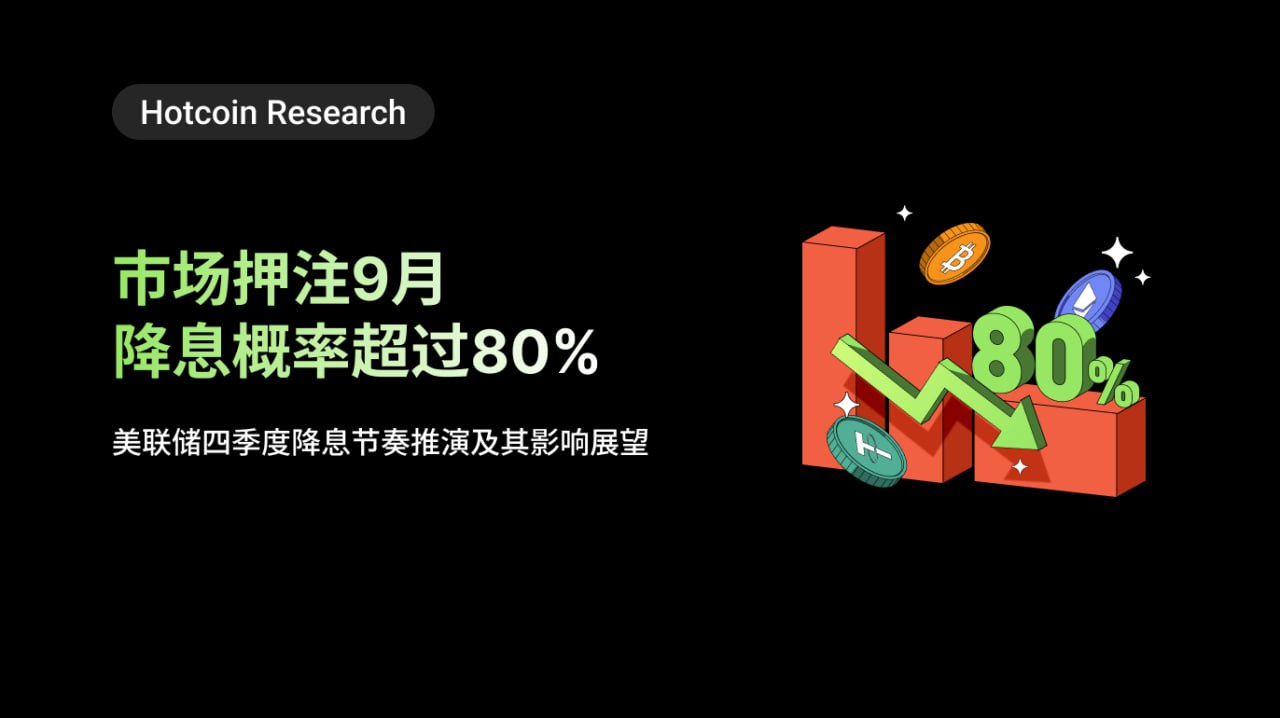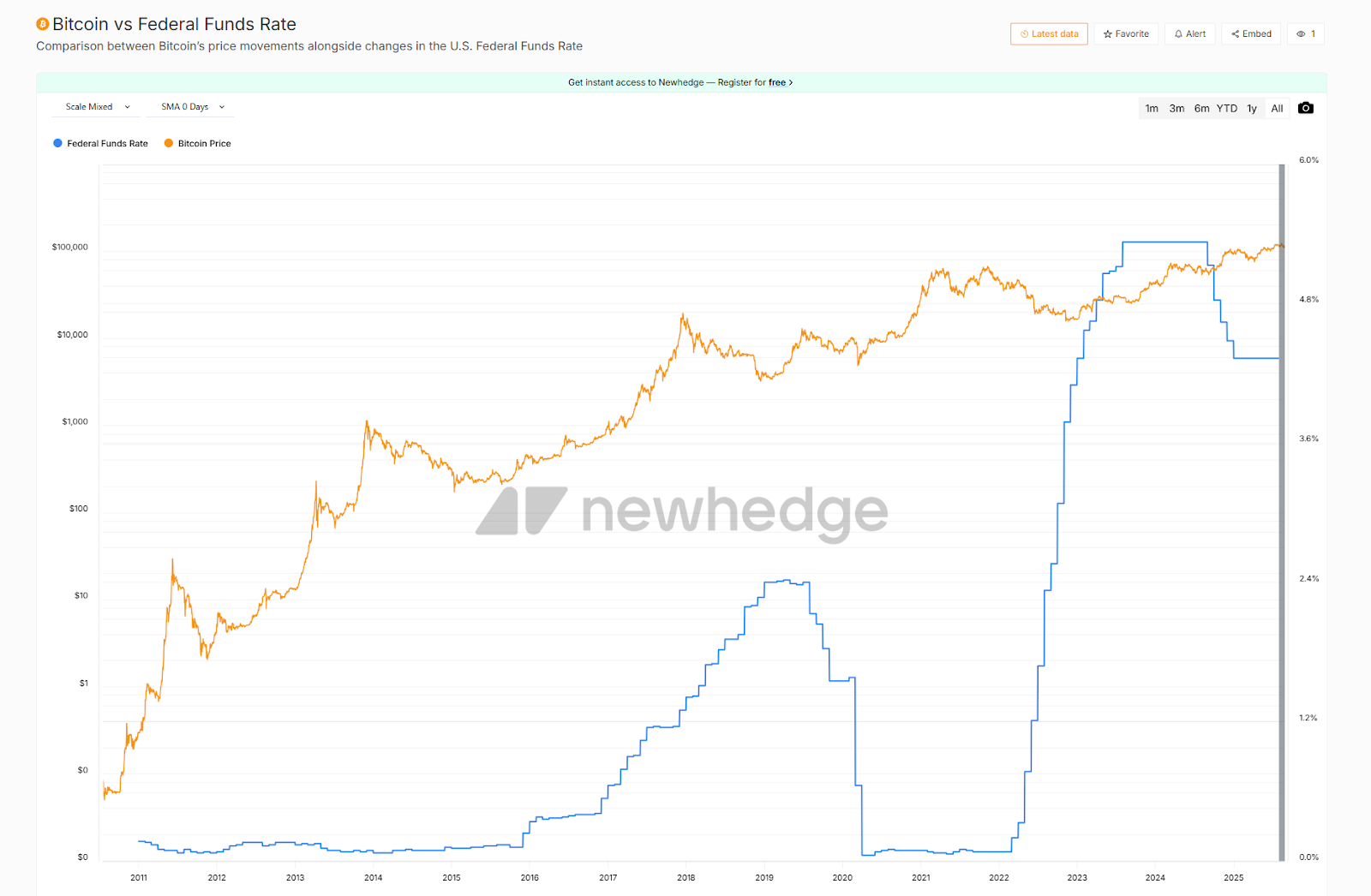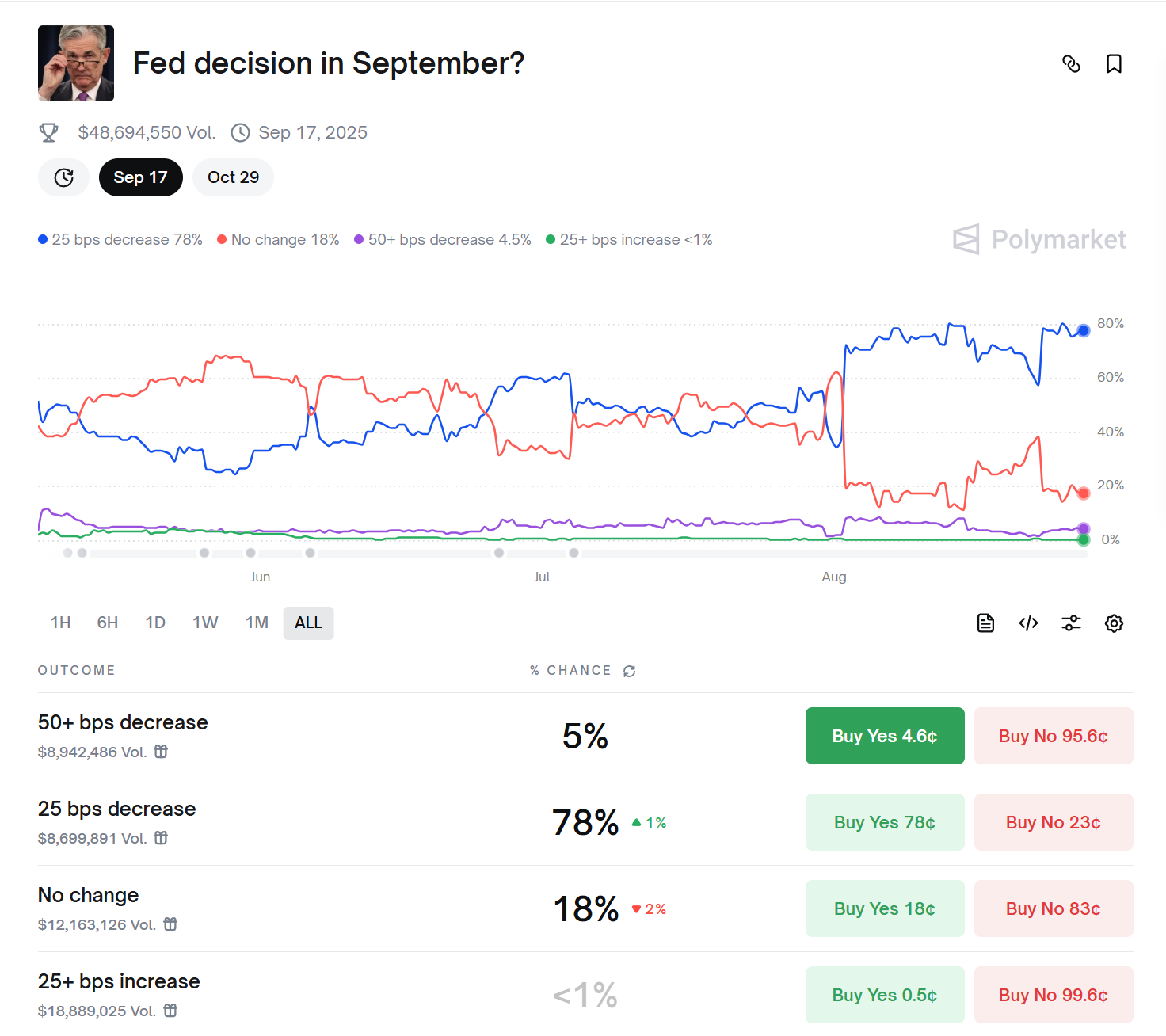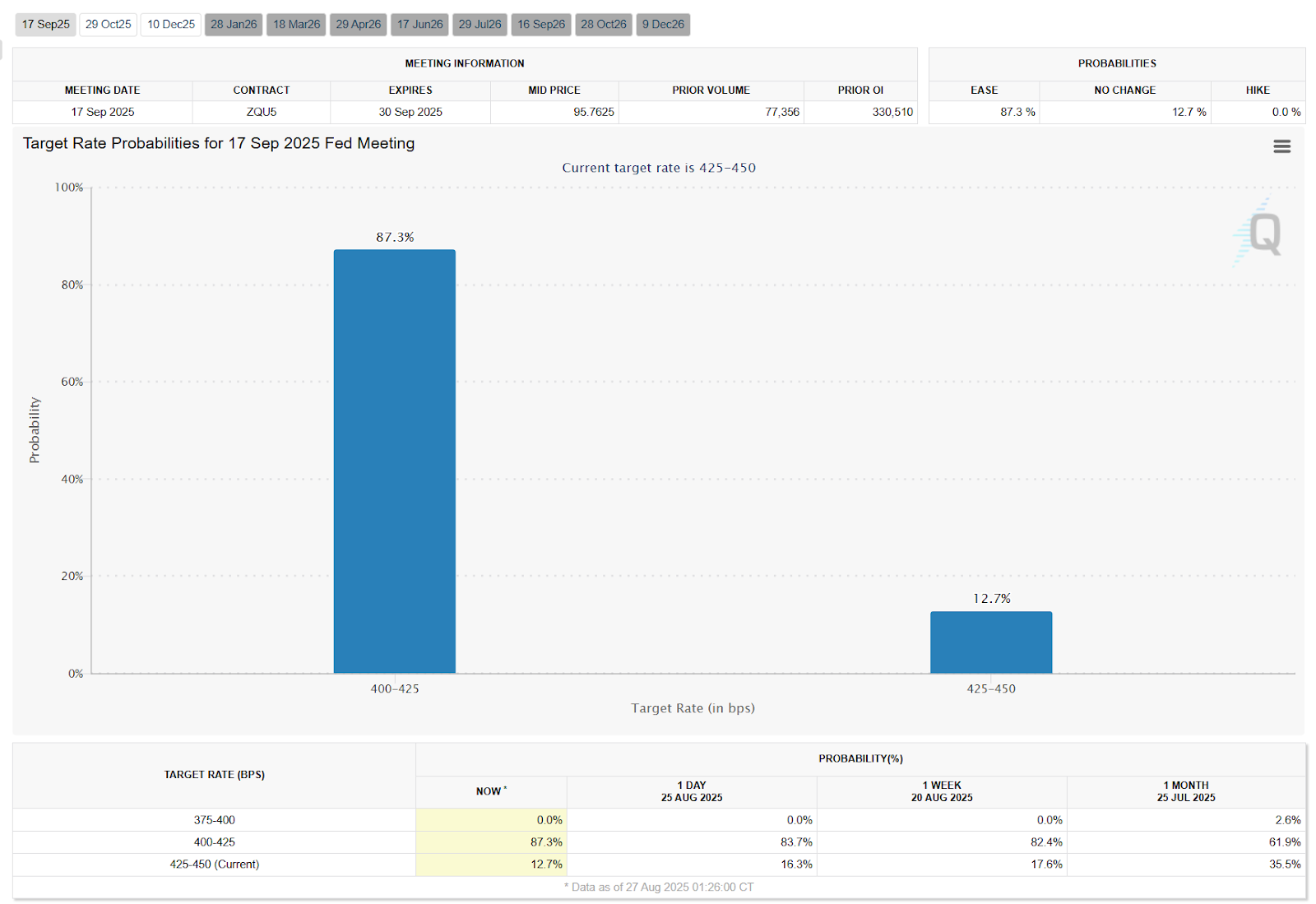
一、引言
8月22日,美联储主席鲍威尔表示劳动力市场下行风险正在上升,可能“需要调整我们的政策立场”,市场普遍预期美联储将在9月FOMC会议上启动降息,这一发言立即引发了风险资产的热烈响应,美股全线走强,加密市场从多日的下行趋势中反转拉升,ETH暴拉并突破前高,最高涨至4956美元附近。
最终驱动美联储利率决策的是就业与通胀的硬数据。时间轴上,关键节点已明朗:FOMC定于9月16—17日召开,9月决议不仅会给出利率决定,还会更新“点阵图”和宏观预测;会前两份“生死数据”,即8月非农与失业率(9月5日发布)、8月CPI(9月11日发布)将基本敲定降息落地与否。这意味着未来三周,任何“打脸式”的数据意外(如工资再加速、服务通胀反弹、失业率意外下行)都可能改变“9月+年内再一次”的顺滑路径。
本文将解读美联储利率决策的依据、降息对加密资产的影响路径与历史经验,并对9月降息的概率及四季度降息节奏进行情景推演,并分析加密货币市场的可能表现,最终为投资者提供多维度展望与概率加权的行情预测。
二、美联储利率政策的决定因素
美联储的双重使命是“充分就业”和“稳定物价”。美联储利率政策的核心工具就是联邦基金利率(Federal Funds Rate)。它是美国商业银行之间在隔夜借贷超额准备金时适用的目标利率区间,由联邦公开市场委员会(FOMC)设定。换言之,这是银行体系内部的“批发借款利率”,通过调整它,美联储得以影响整个金融体系的资金成本和流动性,从而间接作用于信贷利率、美元汇率、资产价格以及就业与通胀的整体走势。
美联储利率政策受就业、通胀与金融条件三大核心因素共同制约,利率政策并非单一指标驱动,而是多重因素交织下的动态平衡过程。整体而言,影响其决策的关键因素主要包括:就业市场(就业人数、失业率、工资增长)、通胀表现(CPI、核心CPI、PCE、通胀预期)、金融条件(信贷利差、股债市场反应、金融稳定风险)等。在2025年当前的宏观背景下,这些因素共同作用,正推动美联储从“长期维持高利率”逐渐转向“酝酿小步宽松”。
1)就业风险上升
7月美国非农就业仅增加 7.3万,显著低于市场预期,同时前期数据也被下修;失业率升至 4.2%。这意味着美国劳动力市场的扩张正在接近“stall speed(失速临界点)”,显示就业已经不再是美联储政策的“安全垫”。就业一旦持续走弱,就会直接触碰美联储“最大就业”的核心目标,迫使其在政策取向上更加偏向宽松。
2)通胀回落受阻但总体温和
通胀方面,7月CPI同比为 2.7%,核心CPI同比 3.1%,环比分别增长0.2%和0.3%,其中核心CPI环比创下今年以来最大月增。虽然通胀水平依旧高于美联储的2%目标,但整体没有恶化成“全面再通胀”。值得注意的是,生产者价格指数(PPI)在上行,反映出上游成本压力正在抬头,而传导至终端消费端的速度仍较慢。这一“上游抬头、下游温和”的格局,意味着通胀在短期内依旧具备黏性,但尚未到失控程度。
3)金融条件与政策沟通
除了硬数据,美联储同样关注金融市场的反馈与稳定性。鲍威尔在杰克逊霍尔的讲话明确释放出“不急于大幅宽松,但为小步校准留下空间”的信号,其核心是以有限降息来缓冲劳动力市场的尾部风险。市场解读为:若就业数据继续走弱、美联储将在9月率先降息25个基点,并可能在年底再度小幅调整。
三、利率政策对加密市场的影响与历史经验分析
美联储的利率决策不仅直接影响美元和美国经济,还会通过金融市场的多层次传导作用,影响包括加密货币在内的全球风险资产。整体来看,这一传导大致可以分为三条主线:利率与折现率渠道、美元与资本流向渠道、风险偏好与资金行为渠道。这三条路径相互交织,共同塑造了加密市场的周期性波动特征。
1)折现率渠道:利率下行抬高风险资产估值
利率是所有资产定价的基石。美联储下调政策利率会带动美债收益率下降,从而降低市场的贴现率。在这种环境下,未来现金流更为遥远的成长型资产估值更容易被抬高,这正是美股科技股与比特币、以太坊等“高久期资产”常在宽松周期跑赢的逻辑。历史上,2020年疫情期间美联储迅速降息并实施QE,直接推动美股与加密市场迎来双重牛市,BTC在一年内由不足1万美元涨至6万美元。相反,在2022年美联储激进加息背景下,比特币和以太坊分别腰斩甚至更多,折现率上升对价格形成压制。
2)美元与资本流向渠道:DXY走弱利好加密
美联储的利率政策同样会通过美元指数(DXY)的强弱影响资本流向。降息往往削弱美元吸引力,使得资金寻找新的价值储藏和高收益标的。在这种背景下,黄金与比特币这类“非主权资产”受益明显。以2019年美联储结束缩表、重启降息为例,美元指数走弱期间,比特币曾快速从低点反弹超100%。而2022年美联储加息与美元强势同步,比特币却一路跌破2万美元大关。这种“美元—比特币”之间的跷跷板关系,是观察政策转向对加密资产影响的重要指标。
3)风险偏好与资金行为渠道:股市与ETF的联动
利率政策通过股市风险偏好进一步影响加密市场。历史数据显示,比特币与纳斯达克指数的相关性在多数时期显著正相关。当美联储释放宽松信号、股市上涨时,加密资产往往获得更大弹性上涨;而股市避险时,加密市场常遭遇放大式下跌。
此外,随着比特币与以太坊现货ETF的推出,政策预期与ETF申购/赎回之间的关系愈发紧密。例如,2024年上半年美联储鸽派转向之际,BTC和ETH ETF连续录得资金净流入,为行情提供了坚实支撑;而在7月与8月初政策不确定加剧时,ETF资金短暂净流出,加密市场即刻出现震荡下跌。这表明,ETF资金行为已经成为利率政策传导到加密资产的直接通道。
2019年以来,每一次货币政策的转折点几乎都伴随着加密市场的趋势性行情,比特币价格与利率的负相关性越来越明显。站在当前时点,当市场普遍押注9月将启动降息时,我们更需要结合这些历史经验与传导路径,思考其将如何塑造下一阶段的加密行情。

来源:https://newhedge.io/bitcoin/bitcoin-vs-federal-funds-rate
四、9月降息概率及不确定性分析
美联储的利率政策正处于关键的转折点。9月17日FOMC会议不仅是一次例行议息,更可能成为2025年全年货币政策的风向标。市场几乎已经在押注“9月先行降息25bp”,但更深层次的问题在于:这一动作是一次性“保险式调整”,还是新一轮降息周期的开端?答案将取决于接下来两份最关键的数据——8月非农就业(9月5日公布)和8月CPI通胀(9月11日公布)。它们将直接决定美联储点阵图的鹰鸽分布,以及市场对四季度政策节奏的预期。
1)9月降息概率
-
就业端:7月非农就业新增仅 7.3万,远低于市场普遍预期,且前值被下修,失业率升至 4.2%。这意味着美国劳动力市场正在快速降温,扩张速度已接近“stall speed”(失速临界点)。如果8月非农继续低迷(例如10万),甚至失业率升至 4.3%及以上,美联储再维持高利率的逻辑将被彻底削弱。就业放缓意味着经济动能不足,这是政策转向的最直接驱动力。
-
通胀端:7月CPI同比 2.7%,核心CPI同比 3.1%,环比分别上涨0.2%和0.3%。尽管核心环比创下年内最大月增,但整体并未走向“全面再通胀”。如果8月CPI环比保持在 0.2%或更低,将为美联储提供充足空间,以“劳动力市场下行风险”为理由启动降息。即便核心CPI意外走高至0.3%或更高,也更多影响年底的再次降息节奏,而不会阻止9月的先行调整。
-
市场定价:CME FedWatch工具显示,9月降息25bp的概率约87.3%;Polymarket预测市场则给出约78%概率。这表明“9月启动降息”已是定价共识。

来源:https://polymarket.com/event/fed-decision-in-september

来源:https://www.cmegroup.com/markets/interest-rates/cme-fedwatch-tool.html
综合来看,美联储几乎没有理由在9月继续“按兵不动”。即便通胀黏性仍在,美联储也更担心劳动力市场的恶化带来系统性风险。因此,9月小步宽松几乎是大概率事件。
2)关键不确定
虽然9月降息已是大概率,但节奏快慢仍取决于8月数据的组合。可以概括为三种可能:
-
就业继续走弱 + 通胀温和
如果8月非农继续低于10万,失业率升至4.3%以上,同时核心CPI环比≤0.2%,那么9月降25bp几乎是铁定事实,且12月再度降息25bp的概率显著上升。这一组合意味着美联储不仅要在9月行动,还会在年底加码以稳住就业。 -
就业反弹 + 通胀偏黏
如果8月非农意外回升至>15万,而核心CPI环比≥0.3%,则9月依旧可能降息(出于“对冲就业尾部风险”的考虑),但点阵图的基调会更鹰派。市场将把这一操作解读为“预防性降息”,而非持续宽松的开端,年底二次降息的概率会被下修。 -
就业与通胀出现错位
若就业改善但通胀下行,或者就业走弱但通胀再度抬升,则政策路径会变得更复杂。例如,若出现“工资再加速+服务通胀黏性回潮”,美联储可能会在9月释放谨慎信号,甚至小概率拖延至10月才采取行动。这种情况虽然概率较低,但一旦发生,将导致市场短期波动显著加剧。
整体而言,9月降息25bp的确定性极高,市场与政策沟通已为这一动作铺路。但四季度的节奏存在较大不确定性,核心取决于就业是否继续恶化和通胀是否保持温和。如果就业疲软与通胀放缓同时出现,美联储将更快下调利率;如果通胀顽固,政策节奏会被放缓,甚至停留在“只降一次”的格局。
五、四季度节奏:三种情景推演与市场含义
如果9月先行降息已基本确定,那么真正的悬念在于10—12月的节奏。其关键取决于就业是否进一步恶化,以及通胀能否保持温和。基于这两大变量,可以推演出三种政策路径:
(A)基线情景:9月+12月累计50bp(概率 ~55%)
-
条件:8月非农继续偏弱,核心CPI温和。
-
政策节奏:9月降息25bp → 10月观望 → 12月再降25bp。
-
市场含义:与投行普遍预测一致(全年累计50bp)。对加密市场而言,这意味着流动性稳步改善,行情偏向渐进式上涨,而非单边爆发。
(B)谨慎情景:仅9月一次降息(概率 ~30%)
-
条件:8月CPI环比≥0.3%,服务通胀黏性;就业未进一步恶化。
-
政策节奏:9月降25bp → 四季度观望。
-
市场含义:短期利好兑现,但点阵图偏鹰压制市场乐观。加密市场或维持震荡,资金追逐热点板块但缺乏持续趋势。
(C)意外情景:四季度加速降息(概率 ~15%)
-
条件:8月非农极弱(5万)、失业率逼近4.5%,同时核心CPI走低。
-
政策节奏:9月降25bp → 10月和12月连续降息,全年累计≥75bp。
-
市场含义:流动性超预期宽松,风险资产全面亢奋。加密市场有望迎来类似2020年的爆发式牛市,比特币和以太坊快速创新高,山寨币与DeFi进入高波动阶段。但若经济下行过深,股市和加密也可能先现剧烈震荡,再进入上涨。
上述三种情景的核心差异在于就业与通胀的组合。基线情景最可能出现(温和宽松),谨慎与意外情景则分别代表“节奏偏慢”与“节奏偏快”。对投资者而言,9月5日与9月11日的数据不仅决定9月FOMC的操作,更将塑造全年剩余时间的市场预期。
结论
综合来看,美国经济“就业放缓+通胀未稳”的组合正将美联储推向转折点,9月开启降息周期的概率高企。这一宏观拐点对近两年承压的加密市场而言,无疑是重大利好:利率下行将扫除压在比特币等风险资产头顶的阴云,重振市场对流动性和增长的信心。从鲍威尔暗示可能降息后市场的迅猛反应可以看出,资本已经在为新一轮行情做准备。当前加密市场正处于宏观与加密行业共振的关键关口,宏观政策拐点叠加主流采纳度提高等催化因素,有望共同塑造下一阶段的行情走向。
然而,正如本文详细分析的,美联储政策对加密市场的影响是多层次的:既有流动性泛滥带来的机遇,也伴随预期博弈下的波动。投资者应密切关注即将发布的就业和通胀等数据,留意政策信号是否兑现市场预期。同时,通过链上数据和市场指标洞察资金动向,我们看到机构和巨鲸已提前布局,但短线回调和筹码交换依然此起彼伏,这意味着行情走势不会一帆风顺。展望未来数月,较大概率的情形是宽松的利率政策环境为加密市场带来持续向上的力量。但无论是惊喜的加速牛市还是意外的延迟降息,实现稳健收益的关键在于动态调整策略和风险管理,关注9月上旬就业、通胀数据以及美联储决议进展,及时根据新信息修正判断。在市场预期一致时保持一份谨慎,当市场恐慌时敢于逆向布局,方能在不确定性中立于不败。
免责声明:本文章仅代表作者个人观点,不代表本平台的立场和观点。本文章仅供信息分享,不构成对任何人的任何投资建议。用户与作者之间的任何争议,与本平台无关。如网页中刊载的文章或图片涉及侵权,请提供相关的权利证明和身份证明发送邮件到support@aicoin.com,本平台相关工作人员将会进行核查。




